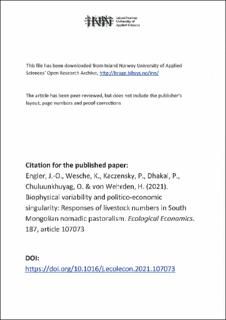Biophysical variability and politico-economic singularity: Responses of livestock numbers in South Mongolian nomadic pastoralism
Engler, John-Oliver; Wesche, Karsten; Kaczensky, Petra; Dhakal, Prabesh; Chuluunkhuyag, Oyundari; von Wehrden, Henrik
Peer reviewed, Journal article
Accepted version
Permanent lenke
https://hdl.handle.net/11250/2990268Utgivelsesdato
2021Metadata
Vis full innførselSamlinger
Originalversjon
10.1016/j.ecolecon.2021.107073Sammendrag
We analyzed a unique data set of livestock numbers in the Mongolian southern Gobi. In a novel approach, we combined biophysical data on precipitation and pasture biomass productivity with data on fine wool prices from 1981 through 2015 to investigate dynamic patterns and responses of livestock numbers in Mongolia’s southern Gobi. Using piecewise structural equation modeling enabled us to disentangle the effects of biophysical and politico-economic factors on livestock numbers and species composition, paying particular attention to the singular transition from centrally planned to free-market economy that happened in Mongolia in 1992. Our analysis reveals that biophysical and politico-economic factors were both important determinants of livestock numbers, and highlights the politico-economic singularity of 1992 as the single-largest driver of livestock dynamics in the period investigated. roductivity Nomadic Herding Gobi Precipitation Variability Post-Soviet Mongolia Extreme Events, Piecewise Structural Equation Modeling

